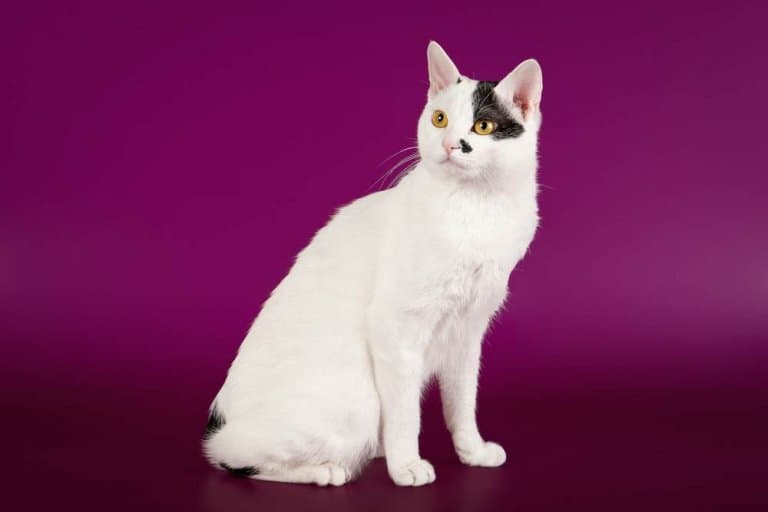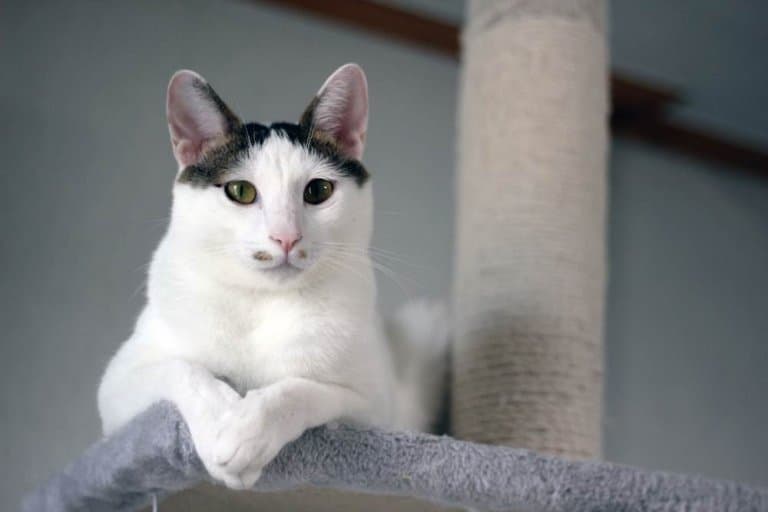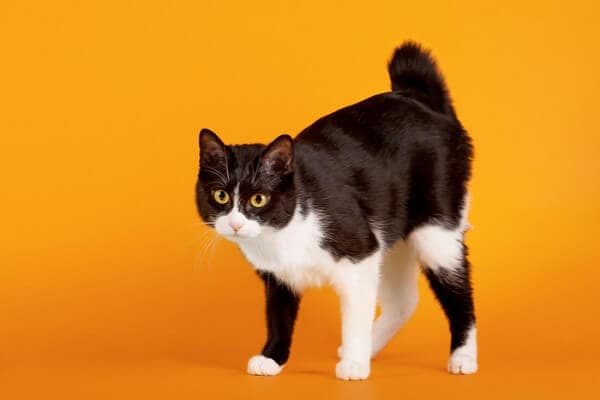
japanese-bobtail
Playful, charming, intelligent, outgoing
Overview
Origin
Japan
Life Span
9-13+ years
Height
10"-14"
Weight
6-10 pounds
Group
Medium-sized shorthair and longhair
Price
$800-$2,000
History

If you guessed that Japanese Bobtail cats are native to the islands of Japan, you're correct! The first cats to arrive in Japan probably came from China or Korea, sometime around 600 to 700 AD, when Buddhist monks needed help keeping rats out of the rice paper scrolls they used for temple records.
As the bobtail gene became more prevalent, more bobtail cats were seen. During the 1600s, rats plagued Japan's silk industry and cats were released from the temples and tasked with the important job of rodent abatement. All Japanese Bobtail cats trace their heritage back to these incredibly helpful feline assistants.
The first Japanese Bobtails to make their way to the United States arrived in 1968, with the help of Elizabeth Freret. The Cat Fanciers' Association (CFA) accepted shorthair Japanese Bobtail cats for championship status in 1976. The longhair Japanese Bobtail cat was granted official recognition much later, in 1993. The International Cat Association (TICA) accepted shorthair Japanese Bobtail cats for competition status in 1979 and the longhair in 1991.
Today, the Japanese Bobtail is recognized by all major registering bodies except the Governing Council of the Cat Fancy.
Care

Nutrition
Japanese Bobtail cats do not have any special nutritional needs. We recommend offering a high-protein diet without too many carbohydrates. If you are not feeding your cat fresh food, it's best to offer a high-quality commercial brand that incorporates real meat or fish as the number one ingredient.
Grooming
The Japanese Bobtail cat benefits from occasional brushing, more frequently if the cat has a medium to long coat. This helps cut back on shedding while reducing the likelihood of hairballs.
Exercise
Japanese Bobtail cats are incredibly athletic, and will happily spend hours playing. These cats love to run and jump, and they take very well to walking on leashes. They typically enjoy adventures and excel at feline agility eventing.
Health
Japanese Bobtail cats typically enjoy great health, and do not have any known genetic disorders specific to the breed.
Breed Standard

Body
The Japanese Bobtail is small to medium size, with straight lines, and a clean, well-muscled appearance. The torso is long and lean, and the overall impression is that of balance. Males are generally larger than females.
Head
The head forms a nearly perfect equilateral triangle shape with gently curved lines, high cheekbones, a long nose, and a noticeable whisker break. Males will exhibit jowls.
Eyes
The Japanese Bobtail cat's eyes are large, wide, and alert, with an oval shape. All eye colors are acceptable, and odd-eyed cats (are seen as desirable.
Ears
The ears are large and expressive. They are set upright, wide apart, and at right angles to the head.
Color
All colors and patterns are acceptable. Nose leather and paw pad colors complement the coat color.
Coat
The coat may be short or long, always soft and silky, without an undercoat. Longhair Japanese Bobtail cats display a frontal ruff, breeches, ear tufts, and tufts of hair between the toes.
Tail
The Japanese Bobtail cat's tail is unique, with one or more curves, kinks, or angles present. The tail may be rigid or flexible, and in harmony with the rest of the cat. The tail has a fluffy appearance, similar to a pom-pom.
Legs & Paws
The legs are long and slender, with an athletic appearance. The hind legs are noticeably longer than the forelegs, with deep angles at the joints that inshore the cat's back appears nearly level when standing. The feet are oval-shaped.
Personality & Temperament

Playful and intelligent, and with an attitude that’s just a touch demanding, the Japanese Bobtail cat is a rare breed with stunning looks, silky fur, and a melodious singsong voice.
If you're lucky enough to bring a Japanese Bobtail cat into your home, you'll have a friend for life. These cats are exceptionally loyal and loving, even though they believe that you live to serve them. They love to follow their favorite people around, meowing and tapping for attention, and bringing toys to ask for games of fetch that can seem to go on forever.
Japanese Bobtail cats are renowned for their friendliness. Many are so outgoing that they will even greet strangers like old friends. They love to be involved in everything, reading the same books you do, playing computer games and surfing the Internet together, and helping you with all of your projects, carrying on a conversation the entire time.
The breed's friendly nature doesn't just extend to humans. These cats typically enjoy the company of other felines and they will readily make friends with dogs, as well.
Most depictions of the Japanese Bobtail cat show the mi-ke color variant, which is pronounced "mee kay." Mi-ke is a unique tricolor pattern (calico) that is normally displayed by female cats.
Even though mi-ke (calico) is the best-known Japanese Bobtail cat color, these cats can be of any shade and pattern including solid colors, van, tabby, and bi-color. Whatever your favorite cat color, it's likely that there's a Japanese Bobtail to match!